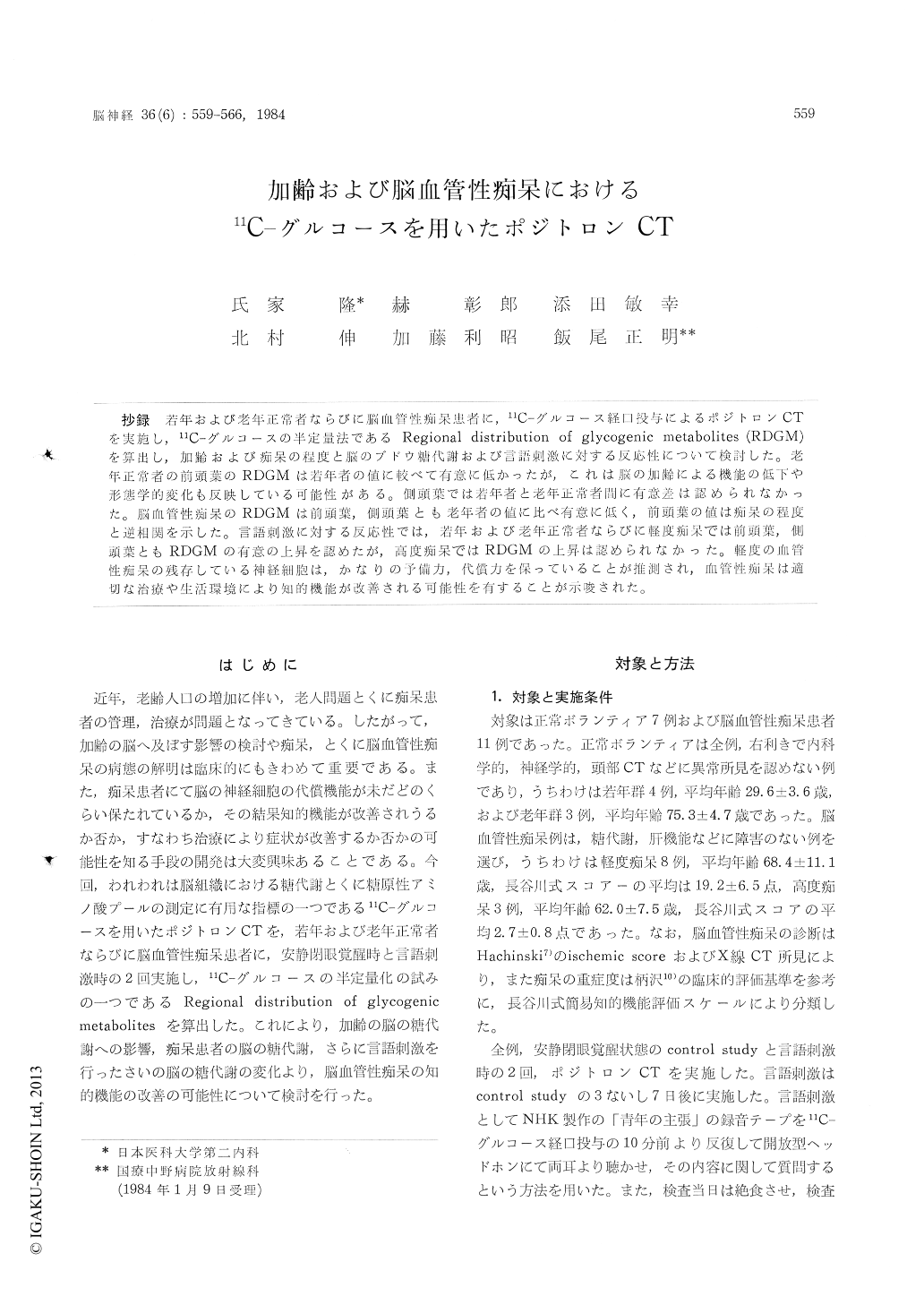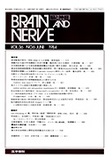Japanese
English
- 有料閲覧
- Abstract 文献概要
- 1ページ目 Look Inside
抄録 若年および老年正常者ならびに脳血管性痴呆患者に,11C—グルコース経日投与によるポジトロンCTを実施し,11C—グルコースの半定量法であるRegional distribution of glycogenic metabolites (RDGM)を算出し,加齢および痴呆の程度と脳のブドウ糖代謝および言語刺激に対する反応性について検討した。老年正常者の前頭葉のRDGMは若年者の値に較べて有意に低かったが,これは脳の加齢による機能の低下や形態学的変化も反映している可能性がある。側頭葉では若年者と老年正常者間に有意差は認められなかった。脳血管性痴呆のRDGMは前頭葉,側頭葉とも老年者の値に比べ有意に低く,前頭葉の値は痴呆の程度と逆相関を示した。言語刺激に対する反応性では,若年および老年正常者ならびに軽度痴呆では前頭葉,側頭葉ともRDGMの有意の上昇を認めたが,高度痴呆ではRDGMの上昇は認められなかった。軽度の血管性痴呆の残存している神経細胞は,かなりの予備力,代償力を保っていることが推測され,血管性痴呆は適切な治療や生活環境により知的機能が改簿される可能性を有することが示唆された。
Seven normal volunteers and 11 patients with cerebrovascular dementia were studied about the relations between effect of aging, severity of dementia, cerebral glucose metabolism and meta-bolic response to verbal stimuli by positron emission tomography (PET) using C-11-glucose administered orally. The diagnosis of cerebrovas-cular dementia was done according to the Hachin-ski's ischemic score and X-ray CT findings, and the severity of dementia was classified according to the DR scale originated by Hasegawa. PET scannings started at 10 minutes and ended at 50 minutes after administration of C-11-glucose, and bloods were sampled at every 5-10 minutes during the PET scannings. Stimulation studies were performed after 3 or 7 days from control studies. An educational broadcasting program was used as the verbal stimuli. Regional distribution of glycogenic metabolites (RDGM : mg/100 g brain), which was a semi-quantitation of the pool of glycogenic metabolites mainly amino acids, were calculated.
The RDGM values in elder normal subjects were significantly low compared with young normal subjects in frontal cortex (p<0.05). The decline in frontal cortex metabolism could have been caused by the morphological changes in the course of aging. In temporal cortex, there was no significance between two groups. RDGM in-creased significantly respond to the verbal stimuli in frontal and temporal cortex both young and elder normal subjects.
The RDGM values in vascular dementias were significantly low (p<0.001) compared with elder normal subjects' in frontal and temporal cortex. Significant difference existed between mild and severe dementia in frontal cortex (p<0.05). How-ever, there was no significance between mild and severe dementias in temporal cortex. In mild dementias, RDGM increased significantly respond to the verbal stimuli in frontal and temporal cortex. In severe dementias, metabolic response to the verbal stimuli was less or lacking.
Our results suggest that the cerebral metabolic functional reserve and the ability of the cerebral cortex to function respond to psychophysiologic stimulation are preserved in young and elder normal subjects and mild cerebrovascular demen-tias. The possibility of improvement of mental functions in mild cerebrovascular dementia on treatment with suitable therapy and circumstance is suggested.
Characterization of "unstimulated state" is in-evitable problem and should be solved in the near future. However, our methods are usefull to study the effect of aging and vascular dementia on cerebral glucose metabolism.

Copyright © 1984, Igaku-Shoin Ltd. All rights reserved.


